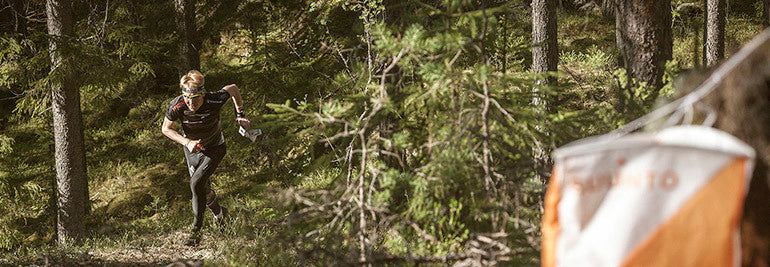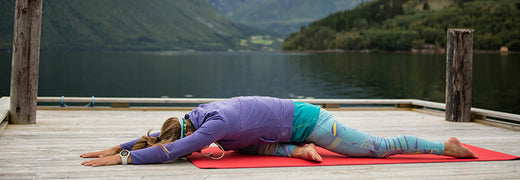

Suunto Blog

Mårten Boström's essential tips for Jukola terrain
The 70th edition of Jukola Relay and the 41st Venla Relay will take the orienteers to Lahti and Hollola in Päijät-Häme Region about an hour north of Helsinki, Finland. The competition area is quite peculiar, as it is dominated by depression terrain formed by the Ice-Age. These depressions make navigating hard; the hollows are not as easy to see in the terrain as hills and rises would be. One also has to read the map carefully; are the contour lines up or down?
“Most of the features we use for navigation are below the main running level, not above as we're used to,” says Mårten Boström.
The depressions vary in size, some are small, some go down as much as 40 meters. Most of the terrain is pine forest with good runnability. There are also a lot of existing trails.
To get an idea of how the maps will look, check this out
“You should not plan on running through all depressions. If there's yellow on the bottom it might be a good idea to run along a depression's bottom, but otherwise, I'd suggest using the ridges between the depressions. Most animal trails and runner's tracks will also be going along the ridges, where you'll be avoiding the excess climb.”
Smart use of compass use is crucial in this year's Jukola.
“Most features you'll use for navigation are contours with soft edges, so it's hard to get your 100% specified location. When going through depressions (be sure you will no matter how well route choices you make) you need to be careful to exit in the correct angle,” says Mårten.
Main image by Kimmo Hirvonen / Lahti-Hollola Jukola, other images by Petri Kovalainen / Suunto
READ MORE
THREE REASONS TO USE A THUMB COMPASS
HOW TO USE SUUNTO AIM-6 THUMB COMPASS
LEARN MORE ABOUT SUUNTO AIM-6

Three reasons to use a thumb compass
The key benefit of a thumb compass over a traditional baseplate compass can be summed to one sentence: It is faster. But what exactly makes an orienteer with a thumb compass go faster?
You can run faster
When using a thumb compass you hold the map and the compass in the same hand. This enables you to keep running while reading the map. “Using both hands for map work turns your running into penguin walk,” says Mårten.
You don't need to place the compass on the map again and again
No more holding your finger on the map to mark your current location and no more need to place the compass back on the map. The compass is already there and pointing to where you want to go.
“A lot of times people are taught to place their thumb on the map where they are. However, I find it more useful to know where I am going and thus want to know what is the next spot where I can get solid confirmation on my location.”
You can take a new direction quicker
There is no need to turn the compass capsule on the AIM-6 thumb compass. Simply see which sector on the compass capsule corresponds with your new direction and go. “I usually memorize the color first and then the shape. But you can create your own system for remembering the correct sector.”
All images: Petri Kovalainen / Suunto
READ MORE
LEARN MORE ABOUT SUUNTO AIM-6 THUMB COMPASS
HOW TO USE SUUNTO AIM-6 THUMB COMPASS
DEVELOPING A NEW ORIENTEERING COMPASS IS A TEAM EFFORT

What you absolutely, positively, must bring and do on your first dive holiday
Packing for vacation should be easy – a couple swimsuits, a pair of flip-flops, some sunscreen, and you’re good to go – right? Not if you’re going diving. To say it’s an equipment-intensive sport is putting it lightly. Good news: you can get your tanks at almost any dive location – so at least you won’t have to put down for overweight baggage fees. But there are a few key items you’re probably going to want. Suunto’s Alec Jones has spent the good part of a decade at the dive paradise of Sharm-El-Sheik as a dive instructor – so he’s a qualified expert.
First off, do a holiday
A dive holiday may sound extravagant, or expensive – but it’s one of the best ways to expand your horizons. “You’ll encounter different conditions, visibility, wildlife – you name it. Diving is about exploration!” says Alec.
Your own fins, mask and snorkel
Fins and masks are pressure points – you get the wrong fit, and you’re going to be uncomfortable all day, and that makes diving less than fun. At that point you might as well chuck in a snorkel. “Rental kit often isn’t so nice,” says Alec. “Even if you’re just getting into it, I really recommend getting a decent, properly fitting mask, and some decent fins.” And if you’re someone who would call themselves a germaphobe, you might, uh, want your own wetsuit, too.
Dry Bags, sunscreen and hydration
You’re probably going to be spending a lot – a lot – of time on a boat in the sun. Sunscreen you know about – but what you might not realize is how much you’ll get dehydrated. Add in that a lot of other counties purify their water – you won’t be getting minerals you’re used to – and it’s a recipe for dehydration. “A lot of people would come to dive in Egypt, get sick, and blame something in the water – but it’s actually dehydration!” says Jones.
Another great thing to bring along? Small or medium-sized dry bags to drag out on the boat – useful for electronics or just keeping a dry t-shirt nearby.
Gaffer tape and zip ties
Why? You don’t know yet. Just bring ‘em.
A dive computer you know
Your dive computer is an essential piece of kit – and since it’s a little complicated, it’s great to go with something you know. The new Suunto EON Core is an easy-to-use, Bluetooth®-equipped dive computer that will log every meter of every dive. With your own kit, you can pre-load it with your own dive plan – a nice bonus. Another hot tip? A portable power bank to keep your dive computer charged.
Keep going further
Water covers over 70% of our planet – there are lots of places to go. “For Europeans, the Red Sea is really close,” Jones says. “But why stop there? There’s Indonesia, the Philippines, Malaysia, the Cenotes in Mexico, the Florida Keys, Costa Rica, the Galapagos – the list is really endless!”
Do everything right, and you’ll have the experience of a lifetime – and you might even make some new friends. “I’ve seen a lot of solo divers come down and make friends that they’ll keep for life,” says Alec. “Now they come back year after year to dive together.”
READ ALSO
A pro diver’s essential tips for newbie divers
10 tips to take amazing underwater photos

Emelie Forsberg's top 7 yoga poses for runners
There is no better way to start the day than by doing yoga. For champion mountain runner Emelie Forsberg, a regular morning yoga practice keeps her life in a balance.
A lot of people have the impression yoga takes an hour or 90 minutes. Not so – Emelie says a regular yoga practice can be short and sweet. A daily practice of 10 to 15 minutes is better than a once-in-a-while 90-minute class. Regular practice brings the results, she says.
Here are her 7 favorite poses. These can be done in a sequence in less than 20 minutes.
Easy seated: One to three minutes
"It’s nice to sit for a few moments before beginning moving just to feel the breath and the body. Simply cross your legs in front of you, and tune into your belly moving in and out with the breath."
Downward Dog: Five to 20 breaths
"I often come into this position even if I don´t do the sun salutations because it’s great for the hamstrings, calf muscles, and the upper back. It also works as a stretch for tight underarms."
"It’s like creating the shape of the letter “A” with the body. Spread the fingers wide, actively push into the hands, breath in and lift your butt up high. Try to distribute weight down evenly through the arms and legs."
Warrior 2: Five to 10 breaths each side
"This pose is great for developing strength in the legs and finding stability by keeping the hips in a balanced position. Align your feet so the front foot’s heel is in line with the arch of the back foot. Keeps the arms out at shoulder height and gaze out over the front fingers. For a more demanding session I hold it for 10 breaths on each side. Keep the front knee above the ankle, the back leg straight and the torso upright."
Click here to read how yoga helps Emily’s life stay in balance
Triangle pose: Five to 10 breaths each side
"Nice stretch for the hamstrings and side body, and also works on balance."
Tree pose: Five breaths each side
"Here we test our balance, using the small muscles in the ankle and foot. Try also to keep a stable and long upper body, as well as ensuring relaxed shoulder blades while holding your arms above your head."
Boat pose: Five to 10 breaths
"Great for working on core strength. Sit on your butt, with the soles of your feet on the mat and your knees up. Sit upright, keeping your spine long. Then lift your feet off the mat, bringing them to knee height, while pointing the toes. Now, lean back carefully, keeping the spine long, and bring your arms forward so the hands are by the knees."
Pigeon pose: Three to 10 breaths
"Great for the glutes! If you’re feeling tired in the IT band, then this pose can really help. Stay here as long as comfortable and work with the breath to slowly (and carefully!) come lower down for deeper work. Be aware of any uncomfortable or painful compression sensations. It’s better to back off and approach this posture gradually over time."
All images by Matti Bernitz / Suunto
More related stories:
How yoga can make you a better mountain runner
How to bring mindfulness to the trail
Five yoga moves for runners

Finding the flow with yoga and running
Emelie Forsberg began practicing yoga when she was 15. Now, 31, it remains a staple in her life, one that keeps her grounded and calm. It’s so important to her in 2016 she traveled to India and completed a yoga teacher training course.
“When I’m in a good flow, when I’m in my routine, I practice daily,” she says. “I think it has always given me a calmness just to sit down to feel the body – it allows me to tune into how the muscles are feeling, where the tender spots are, what needs attention. It gives me the sensitivity to be able to listen to the body.”
Listening to the body is central to the training philosophy of her and her partner Kilian Jornet. Rather than complex tables and stats, they depend on a sensitive receptiveness to what the body is telling them on any given day. For Emelie, yoga helps this process.
“The whole philosophy of yoga, the mindfulness part, can really make me a better person and in that way it makes me a better athlete,” she says. It helps me focus and to accept the ups and downs.”
She likes to start her morning on her yoga mat so she can tune into whether her body is feeling tired, the level of stiffness, mental sharpness, or whether or not there are the subtle signs telling her an injury is forming. This awareness is essential, she says, to balancing her training and recovery time.
Click here for Emelie's top 7 yoga poses for runners
“When I make the time for yoga I really feel good. I’m in more of a flow. It’s really helped me stay in balance,” she says.
After a big training week or race, Emelie rolls out her yoga mat to begin the process of recovery. She begins with gentle movements that synchronize her breathing with gentle spinal movements, slowly warming the body and releasing some of the unnecessary stiffness.
“After a big race or week it’s nice to move my body in another way,” she says. “The stretching helps for sure, to feel a bit relaxed in the body after hard training. It helps me maintain my upper body flexibility, as I’m quite stiff in the upper body, around the shoulder blades. For some others, it might be hips and glutes.”
In the media and online yoga is often depicted as being the domain of thin, ultra-flexible women who look like elite gymnasts. For many people, especially athletes, this can be a turn-off. Strength, stability and stamina are prized, not the contortionism.
Emelie says this is not what yoga really is and not how she, as an athlete, approaches it. Having a good yoga teacher, who understands physiology and sports science, is important.
“It’s not important for me to be really flexible,” she says. “As athletes we use our muscles in a very different way. I have stiffness I need as a runner, for example a stiff lower back – I don’t want to work on that.
“I won’t do many of the back bending yoga poses because they are not good for running. It’s important to know your body and how yoga can affect your running.”
All images by Matti Bernitz / Suunto
More related stories:
How yoga can make you a better mountain runner
How to bring mindfulness to the trail
Five yoga moves for runners

Kilian Jornet – Running 30's
“I had a big accident four years ago and dislocated both of my shoulders at the same time. Since then I have dislocated them a few times every year. I knew I needed to get this surgery. It was mandatory,” says Kilian.
“I am an outdoor person. I don’t want to be stuck inside, but I knew I needed to stay one or two months indoors. That was hard, but I was mentally prepared for that.”
Watch the video and see the Kilian copes with the slow recovery process of two operated shoulders at once.










































































